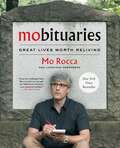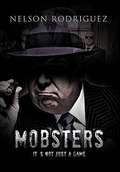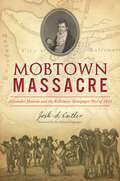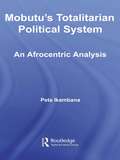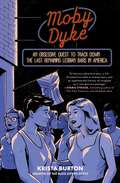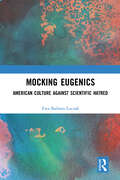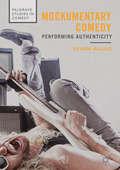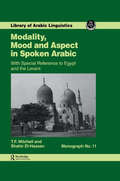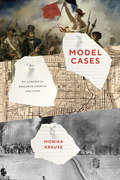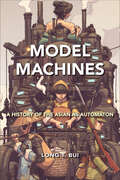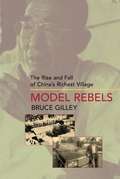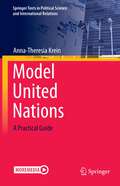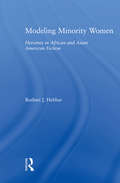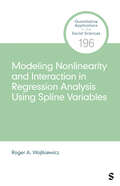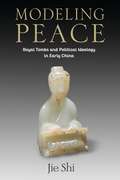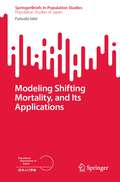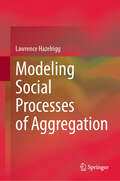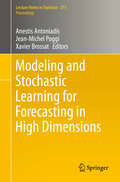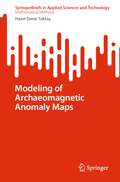- Table View
- List View
Mobilizing the U.S. Latinx Vote: Media, Identity, and Politics (Routledge Focus on Digital Media and Culture)
by Arthur D. Soto-VásquezThis book examines the politics involved in the mobilization of the Latinx vote in America. Delving into the questions of race and identity formation in conjunction with the role of communication media, the author discusses the implications for Latinx voters and their place in the American political and racial system. Utilizing an in-depth study of the mobilizing efforts of national Latinx groups, along with a rigorous analysis of online media, news media, and electoral results, this book discusses: How the old notions of white and black America clash with the growing focus on Latinos How political organizers develop and use messages of racial solidarity to motivate people, what technologies are at their disposal, and what their use means How the study of new media is vital to exploring race in the 21st century, and why communication cannot ignore the racial legacies of the 20th century Theoretically located in between the fields of communication and racial/ethnic studies, this book will be of great relevance to scholars and students working in the field of communication studies, political communication, Latinx studies, and sociology.
Mobituaries: Great Lives Worth Reliving
by Mo RoccaFrom beloved CBS Sunday Morning correspondent and humorist Mo Rocca, an entertaining and rigorously researched book that celebrates the dead people who have long fascinated him. <P><P>Mo Rocca has always loved obituaries—reading about the remarkable lives of global leaders, Hollywood heavyweights, and innovators who changed the world. But not every notable life has gotten the send-off it deserves. His quest to right that wrong inspired Mobituaries, his #1 hit podcast. <P><P>Now with Mobituaries, the book, he has gone much further, with all new essays on artists, entertainers, sports stars, political pioneers, founding fathers, and more. Even if you know the names, you’ve never understood why they matter...until now. Take Herbert Hoover: before he was president, he was the “Great Humanitarian,” the man who saved tens of millions from starvation. But after less than a year in the White House, the stock market crashed, and all the good he had done seemed to be forgotten. <P><P>Then there’s Marlene Dietrich, well remembered as a screen goddess, less remembered as a great patriot. Alongside American servicemen on the front lines during World War II, she risked her life to help defeat the Nazis of her native Germany. And what about Billy Carter and history’s unruly presidential brothers? Were they ne’er-do-well liabilities…or secret weapons? <P><P>Plus, Mobits for dead sports teams, dead countries, the dearly departed station wagon, and dragons. Yes, dragons. Rocca is an expert researcher and storyteller. He draws on these skills here. With his dogged reporting and trademark wit, Rocca brings these men and women back to life like no one else can. Mobituaries is an insightful and unconventional account of the people who made life worth living for the rest of us, one that asks us to think about who gets remembered, and why. <P><P><b>A New York Times Bestseller</b>
Mobster: It's Not Just A Game
by Nelson RodriguezIn this story based on true events, author Nelson Rodriguez explores the effects of an online game called Mobster on its players. Rodriguez examines how people interact with others when they are involved-or even obsessed-with online gaming, delving into the relationships that are built through the game-sometimes with others who live a completely different part of the world For Sam, the game Mobster became an extremely personal and real experience; he began acting out his crimes in real life, without giving any thought to the law or the lines that he was crossing. To "win," he did everything in his power, regardless of the consequence-making bribes and intimidating anyone he perceived was in his way. But would he take to ultimate step and actually kill someone? Mark was committed to his job as a police officer, and so he never imagined that one day he would have to engage in the very acts that he had sworn to fight. It seemed that destiny had a different path for him-a life he never imagined for himself. Despite their strong personal relationships, once these players get caught up in the game, all that matters to them is the game-and everything they cared about before is in jeopardy.
Mobtown Massacre: Alexander Hanson and the Baltimore Newspaper War of 1812 (True Crime)
by Josh S. CutlerWinner of the 2020 Baltimore History Prize, this is a gripping account of how a Federalist editor risked his life to defend his anti-war views. With a bitterly divided nation plunged into the War of 1812, Alexander Hanson penned an anti-war editorial that provoked a violent standoff that crippled the city of Baltimore and left Hanson beaten within an inch of his life. This little-known episode in American history—complete with a midnight jailbreak, bloodthirsty mobs and unspeakable acts of torture—helped shape the course of war, the Federalist Party and the nation&’s very notion of the freedom of the press. Josh Cutler&’s history of the Mobtown Massacre offers a lesson in liberty that reverberates today. &“A compelling story that&’s as timely today as it was two centuries ago.&” —Congressman William R. Keating &“A remarkably vivid, engaging and very readable account of a brief but major event in Baltimore history . . . which reflected the sharp political divisiveness of the time at the start of the War of 1812, and had important implications for freedom of the press and the war itself.&”—Charles Markell, board member, Baltimore City Historical Society &“A timely and scholarly examination of one man&’s struggle for freedom of the press.&”—Fred Dorsey, Howard County, MD historian &“Cutler&’s book tells not only of politics of that era and the controversy of a war that ultimately led to the burning of the White House and the writing of &‘The Star-Spangled Banner&’ by Francis Scott Key, but also how it challenged America&’s devotion to a free press.&” —The Baltimore Sun
Mobutu's Totalitarian Political System: An Afrocentric Analysis (African Studies)
by Jean-Louis Peta IkambanaMobutu's political system, inaugurated in 1965 and lasting more than three decades, met all the characteristics of totalitarianism. This study shows that the failures and misdeeds of Mobutu's system were clear evidence that it lacked an African-centred vision and did not put the interests of the African people of Congo (formerly Zaire) at the centre of this political project. In this study Mobutu's political actions in the 1990s - mostly as they related to the National Sovereign Conference - are critically analyzed and found to be a deliberate attempt to obstruct the momentum of democracy for the African people of Congo. From an Afro centric standpoint, this obstruction is evidence of Mobutu's attempt to impede the search for harmony and peace by the Zairian people, and to reject the African-centred truth that without Ma'at (harmony) there is no understanding and no possible restoration of balance. Mobutu's Totalitarian Political System will be of interest to students and scholars of ethnic studies, political science and international relations.
Moby Dyke: An Obsessive Quest To Track Down The Last Remaining Lesbian Bars In America
by Krista BurtonA former Rookie contributor and creator of the popular blog Effing Dykes investigates the disappearance of America&’s lesbian bars by visiting the last few in existence.Lesbian bars have always been treasured safe spaces for their customers, providing not only a good time but a shelter from societal alienation and outright persecution. In 1987, there were 206 of them in America. Today, only a couple dozen remain. How and why did this happen? What has been lost—or possibly gained—by such a decline? What transpires when marginalized communities become more accepted and mainstream? In Moby Dyke, Krista Burton attempts to answer these questions firsthand, venturing on an epic cross-country pilgrimage to the last few remaining dyke bars. Her pilgrimage includes taking in her first drag show since the onset of the pandemic at The Back Door in Bloomington, Indiana; competing in dildo races at Houston&’s Pearl Bar; and, despite her deep-seated hatred of karaoke, joining a group serenade at Nashville&’s Lipstick Lounge and enjoying the dreaded pastime for the first time in her life. While Burton sets out on the excursion to assess the current state of lesbian bars, she also winds up examining her own personal journey, from coming out to her Mormon parents to recently marrying her husband, a trans man whose presence on the trip underscores the important conversation about who precisely is welcome in certain queer spaces—and how they and their occupants continue to evolve. Moby Dyke is an insightful and hilarious travelogue that celebrates the kind of community that can only be found in windowless rooms soundtracked by Britney Spears-heavy playlists and illuminated by overhead holiday lights no matter the time of year.
Mock Modernism
by Leonard DiepeveenHow was the modernist movement understood by the general public when it was first emerging? This question can be addressed by looking at how modernist literature and art were interpreted by journalists in daily newspapers, mainstream magazines like Punch and Vanity Fair, and literary magazines. In the earliest decades of the movement - before modernist artists were considered important, and before modernism's meaning was clearly understood - many of these interpretations took the form of parodies.Mock Modernism is an anthology of these amusing pieces, the overwhelming majority of which have not been in print since the first decades of the twentieth century. They include Max Beerbohm's send-up of Henry James; J.C. Squire's account of how a poet, writing deliberately incomprehensible poetry as a hoax, became the poet laureate of the British Bolshevist Revolution; and the Chicago Record-Herald's account of some art students' "trial" of Henri Matisse for "crimes against anatomy." An introduction and headnotes by Leonard Diepeveen highlight the usefulness of these pieces for comprehending media and public perceptions of a form of art that would later develop an almost unassailable power.
Mocking Eugenics: American Culture against Scientific Hatred
by Ewa Barbara LuczakMocking Eugenics explores the opposition to eugenic discourse mounted by twentieth-century American artists seeking to challenge and destabilize what they viewed as a dangerous body of thought. Focusing on their wielding of humor to attack the contemporaneous science of heredity and the totalitarian impulse informing it, this book confronts the conflict between eugenic theories presented as grounded in scientific and metaphysical truth and the satirical treatment of eugenics as not only absurdly illogical but also antithetical to democratic ideals and inimical to humanistic values. Through analyses of the films of Charlie Chaplin and the fiction of F. Scott Fitzgerald, Ernest Hemingway, Anita Loos, and Wallace Thurman, Mocking Eugenics examines their use of laughter to dismantle the rhetoric of perfectionism, white supremacy, and nativism that shaped mainstream expressions of American patriotism and normative white masculinity. As such, it will appeal to scholars of cultural studies, literature, cinema, sociology, humor, and American studies.
Mocking Eugenics: American Culture against Scientific Hatred
by Ewa Barbara LuczakMocking Eugenics explores the opposition to eugenic discourse mounted by twentieth-century American artists seeking to challenge and destabilize what they viewed as a dangerous body of thought. Focusing on their wielding of humor to attack the contemporaneous science of heredity and the totalitarian impulse informing it, this book confronts the conflict between eugenic theories presented as grounded in scientific and metaphysical truth and the satirical treatment of eugenics as not only absurdly illogical but also antithetical to democratic ideals and inimical to humanistic values. Through analyses of the films of Charlie Chaplin and the fiction of F. Scott Fitzgerald, Ernest Hemingway, Anita Loos, and Wallace Thurman, Mocking Eugenics examines their use of laughter to dismantle the rhetoric of perfectionism, white supremacy, and nativism that shaped mainstream expressions of American patriotism and normative white masculinity. As such, it will appeal to scholars of cultural studies, literature, cinema, sociology, humor, and American studies.
Mockumentary Comedy: Performing Authenticity (Palgrave Studies in Comedy)
by Richard WallaceThis book is the first to take comedy seriously as an important aspect of the popular mockumentary form of film and television fiction. It examines the ways in which mockumentary films and television programmes make visible—through comedy—the performances that underpin straight documentaries and many of our public figures. Mockumentary Comedy focuses on the rock star and the politician, two figures that regularly feature as mockumentary subjects. These public figures are explored through detailed textual analyses of a range of film and television comedies, including A Hard Day’s Night, This is Spinal Tap, The Thick of It, Veep and the works of Christopher Guest and Alison Jackson. This book broadens the scope of existing mockumentary scholarship by taking comedy seriously in a sustained way for the first time. It ultimately argues that the comedic performances—by performers and of documentary conventions—are central to the form’s critical significance and popular appeal.
Modality, Mood and Aspect in Spoken Arabic
by T.F. Mitchell S.A. ai-HassanFirst published in 1995. Part of the library of Arabic Linguistics series which devotes itself to all issues of Arabic linguistics in all its manifestations on both the theoretical and applied levels. The results of these studies will also be of use in the field of linguistics in general, as well as related subjects. This book is Monography 11 and looks at modality, mood and aspect in spoken Arabic with special reference to Egypt and the Levant.
Model Airplanes are Decadent and Depraved: The Glue-Sniffing Epidemic of the 1960s
by Thomas AielloModel Airplanes are Decadent and Depraved tells the story of the American glue-sniffing epidemic of the 1960s, from the first reports of use to the unsuccessful crusade for federal legislation in the early 1970s. The human obsession with inhalation for intoxication has deep roots, from the oracle at Delphi to Judaic biblical ritual. The discovery of nitrous oxide, ether, and chloroform in the late 18th and early 19th centuries and the later development of paint thinners, varnishes, lighter fluid, polishes, and dry-cleaning supplies provided a variety of publicly available products with organic solvents that could be inhaled for some range of hallucinogenic or intoxicating effect. Model airplane glue was one of those products, but did not appear in warnings until the first reports of problematic behavior appeared in 1959, when children in several western cities were arrested for delinquency after huffing glue. Newspaper coverage both provided the initial shot across the bow for research into the subject and convinced children to give it a try. This "epidemic" quickly spread throughout the nation and the world. Though the hobby industry began putting an irritant in its model glue products in 1969 to make them less desirable to sniff, that wasn't what stopped the epidemic. Just as quickly as it erupted, the epidemic stopped when the media coverage and public hysteria stopped, making it one of the most unique epidemics in American history. The nation's focus drifted from adolescent glue sniffing to the countercultural student movement, with its attendant devotion to drug use, opposition to the Vietnam War, southern race policies, and anti-bureaucracy in general. This movement came to embody a tumultuous era fraught with violence, civil disobedience, and massive sea changes in American life and law—glue sniffing faded by comparison.
Model Cases: On Canonical Research Objects and Sites
by Monika KrauseIn Model Cases, Monika Krause asks about the concrete material research objects behind shared conversations about classes of objects, periods, and regions in the social sciences and humanities. It is well known that biologists focus on particular organisms, such as mice, fruit flies, or particular viruses when they study general questions about life, development, and disease. Krause shows that scholars in the social sciences and humanities also draw on some cases more than others, selecting research objects influenced by a range of ideological but also mundane factors, such as convenience, historicist ideas about development over time, schemas in the general population, and schemas particular to specific scholarly communities. Some research objects are studied repeatedly and shape our understanding of more general ideas in disproportionate ways: The French Revolution has profoundly influenced our concepts of revolution, of citizenship, and of political modernity, just like studies of doctors have set the agenda for research on the professions. Based on an extensive analysis of the role of model cases in different fields, Krause argues that they can be useful for scholarly communities if they are acknowledged and reflected as particular objects; she also highlights the importance of research strategies based on neglected research objects and neglected combinations of research objects and scholarly concerns.
Model Machines: A History of the Asian as Automaton (Asian American History & Cultu)
by Long T. BuiIn the contemporary Western imagination, Asian people are frequently described as automatons, which disavows their humanity. In Model Machines, Long Bui investigates what he calls Asian roboticism or the ways Asians embody the machine and are given robotic characteristics. Bui offers the first historical overview of the overlapping racialization of Asians and Asian Americans through their conflation with the robot-machine nexus. He puts forth the concept of the “model machine myth,” which holds specific queries about personhood, citizenship, labor, and rights in the transnational making of Asian/America. The case studies in Model Machines chart the representation of Chinese laborers, Japanese soldiers, Asian sex workers, and other examples to show how Asians are reimagined to be model machines as a product of globalization, racism, and colonialism. Moreover, it offers examples of how artists and everyday people resisted that stereotype to consider different ways of being human. Starting from the early nineteenth century, the book ends in the present with the new millennium, where the resurgence of China presages the “rise of the machines” and all the doomsday scenarios this might spell for global humanity at large.
Model Rebels: The Rise and Fall of China's Richest Village
by Bruce GilleyThis narrative about rural life and development in post-Mao China which also engages a scholarly political science debate about the reasons for political resistance.
Model United Nations: A Practical Guide (Springer Texts in Political Science and International Relations)
by Anna-Theresia KreinThis textbook presents a detailed insight into the structures and processes of preparing students for Model United Nations (MUN) conferences and for attending Model United Nations conferences, subsequently. It serves as a handbook and practical guide for the implementation of MUN into courses and classes in educational institutions.Written by a Faculty Advisor, and offering additional insights from an experienced award-winning MUN delegate, the book provides a particularly exceptional insightful, and well-rounded approach. The author explains how a MUN course can be taught, presents exercises to prepare students for the conference, and discusses how the MUN delegation and trip to the conference can be organized. This comprehensive guide offers insights into a broad range of topics, including debates with peers, diplomacy to solve international crises, and learning about the system of the United Nations (UN) organization through simulation. Further, it covers the development of soft skills and communication at the conferences and building international friendships, while it additionally allows learning more about the UN Sustainable Development Goals (SDGs) in the process.With tips, tricks, and bonus material this book will serve as an anchor throughout the students' first MUN experience, as well as provide valuable help for more advanced participants. The book, therefore, is a must-read for both academic staff teaching MUN, as well as students attending MUN courses and planning to attend MUN conferences.
Model-Based Reasoning in Science and Technology: Inferential Models for Logic, Language, Cognition and Computation (Studies in Applied Philosophy, Epistemology and Rational Ethics #49)
by Lorenzo Magnani Ángel Nepomuceno-Fernández Francisco J. Salguero-Lamillar Cristina Barés-Gómez Matthieu FontaineThis book discusses how scientific and other types of cognition make use of models, abduction, and explanatory reasoning in order to produce important and innovative changes in theories and concepts. Gathering revised contributions presented at the international conference on Model-Based Reasoning (MBR18), held on October 24–26 2018 in Seville, Spain, the book is divided into three main parts. The first focuses on models, reasoning, and representation. It highlights key theoretical concepts from an applied perspective, and addresses issues concerning information visualization, experimental methods, and design. The second part goes a step further, examining abduction, problem solving, and reasoning. The respective papers assess different types of reasoning, and discuss various concepts of inference and creativity and their relationship with experimental data. In turn, the third part reports on a number of epistemological and technological issues. By analyzing possible contradictions in modern research and describing representative case studies, this part is intended to foster new discussions and stimulate new ideas. All in all, the book provides researchers and graduate students in the fields of applied philosophy, epistemology, cognitive science, and artificial intelligence alike with an authoritative snapshot of the latest theories and applications of model-based reasoning.
Modeling Minority Women: Heroines in African and Asian American Fiction (Studies in Asian Americans)
by Reshmi J. HebbarThis powerful study reconceptualizes ideas of ethnic literature while investigating the construction of ethnic heroines, shifting the focus away from cultural politics and considering instead narrative or poetic qualities which involve surprising relationships between Anglo-American women's writing and fiction produced by Asian American and African American women authors.
Modeling Nonlinearity and Interaction in Regression Analysis Using Spline Variables (Quantitative Applications in the Social Sciences)
by Roger A. Wojtkiewicz"Spline variables and their interactions play a crucial role in the field of social science. This book offers a comprehensive and detailed exploration of this method, providing valuable insights and information for researchers in the field." --Man-Kit Lei, The University of Georgia This volume addresses the issue of linear constraints in regression modeling. Author Roger A. Wojtkiewicz uses the method of knotted spline variables (also known as piecewise linear regression) and a new method involving group spline variables to model nonlinearity in a variety of situations. Using spline variables to model nonlinearity allows researchers to specify unrestricted models for models that involve interval variables, allowing for greater flexibility in modeling any possible interaction.
Modeling Nonlinearity and Interaction in Regression Analysis Using Spline Variables (Quantitative Applications in the Social Sciences)
by Roger A. Wojtkiewicz"Spline variables and their interactions play a crucial role in the field of social science. This book offers a comprehensive and detailed exploration of this method, providing valuable insights and information for researchers in the field." --Man-Kit Lei, The University of Georgia This volume addresses the issue of linear constraints in regression modeling. Author Roger A. Wojtkiewicz uses the method of knotted spline variables (also known as piecewise linear regression) and a new method involving group spline variables to model nonlinearity in a variety of situations. Using spline variables to model nonlinearity allows researchers to specify unrestricted models for models that involve interval variables, allowing for greater flexibility in modeling any possible interaction.
Modeling Peace: Royal Tombs and Political Ideology in Early China (Tang Center Series in Early China)
by Jie ShiAmong hundreds of thousands of ancient graves and tombs excavated to date in China, the Mancheng site stands out for its unparalleled complexity and richness. It features juxtaposed burials of the first king and queen of the Zhongshan kingdom (dated late second century BCE). The male tomb occupant, King Liu Sheng (d. 113 BCE), was sent by his father, Emperor Jing (r. 157–141 BCE), to rule the Zhongshan kingdom near the northern frontier of the Western Han Empire, neighboring the nomadic Xiongnu confederation.Modeling Peace interprets Western Han royal burial as a political ideology by closely reading the architecture and funerary content of this site and situating it in the historical context of imperialization in Western Han China. Through a study of both the archaeological materials and related received and excavated texts, Jie Shi demonstrates that the Mancheng site was planned and designed as a unity of religious, gender, and intercultural concerns. The site was built under the supervision of the future occupants of the royal tomb, who used these burials to assert their political ideology based on Huang-Lao and Confucian thought: a good ruler is one who pacifies himself, his family, and his country. This book is the first scholarly monograph on an undisturbed and fully excavated early Chinese royal burial site.
Modeling Shifting Mortality, and Its Applications (SpringerBriefs in Population Studies)
by Futoshi IshiiThis book describes a novel method for mortality modeling applying the shifting feature of the mortality curve. In Japan, the increase and pace of the extension in life expectancy have been quite remarkable. Therefore, existing mortality models often cannot capture the peculiarities of Japanese mortality, nor can the Lee–Carter model, which is now regarded internationally as a standard model. One of the important concepts to model recent Japanese mortality is a shifting feature. In this book, the linear difference model, which has many advantages for modeling and analyzing Japanese mortality, is introduced. The book shows applications of the model to mortality projection with a tangent vector field approach and decomposition of the change of modal age at death. The models introduced here are useful tools for modeling mortality with strong shifting features, as in Japan.
Modeling Social Processes of Aggregation
by Lawrence HazelriggThis book demonstrates, via formal statements and empirical illustrations, that nonlinearities in social processes can be modeled systematically to create solutions with practical applications in the institutional forms of paid employment, schooling, and familial relations including marital and kinship ties and the rearing of children. It shows how social processes can be modeled accurately through analyzing time series data—specifically, a temporal sequence of process outcomes that is dense enough in observation time to support appropriate techniques of modeling the outcome sequence. The book illustrates techniques using minimal mathematical formalism which is explained also in careful narrative descriptions of the model logic.
Modeling and Stochastic Learning for Forecasting in High Dimensions
by Jean-Michel Poggi Anestis Antoniadis Xavier BrossatThe chapters in this volume stress the need for advances in theoretical understanding to go hand-in-hand with the widespread practical application of forecasting in industry. Forecasting and time series prediction have enjoyed considerable attention over the last few decades, fostered by impressive advances in observational capabilities and measurement procedures. On June 5-7, 2013, an international Workshop on Industry Practices for Forecasting was held in Paris, France, organized and supported by the OSIRIS Department of Electricité de France Research and Development Division. In keeping with tradition, both theoretical statistical results and practical contributions on this active field of statistical research and on forecasting issues in a rapidly evolving industrial environment are presented. The volume reflects the broad spectrum of the conference, including 16 articles contributed by specialists in various areas. The material compiled is broad in scope and ranges from new findings on forecasting in industry and in time series, on nonparametric and functional methods and on on-line machine learning for forecasting, to the latest developments in tools for high dimension and complex data analysis.
Modeling of Archaeomagnetic Anomaly Maps (SpringerBriefs in Applied Sciences and Technology)
by Hazel Deniz ToktayThis book deals with magnetic anomaly maps and their properties. These properties are essential to modeling the elimination of the uncertainty problem of buried archaeological structure locations and depths. To this end, several models are presented and their quantitative properties are studied. Numerical simulations have been created, confirming theoretical results that were obtained.

